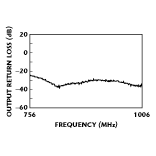A Surface-mount Balun for TV Broadcast Applications
Anaren Microwave Inc.
East Syracuse, NY
Significant growth can be expected in the television (TV) broadcast market due to the new availability of digital TV and governmental requirements forcing broadcasters to transmit a set number of programs in the new digital format. The new standards, along with the desire to reduce the number of different power amplifiers (PA) used in transmitters, have forced PA developers to focus on one module that covers the entire frequency range from 470 to 860 MHz. Traditionally, TV broadcast has been covered by multiple narrower-band PAs. Typical output power of a single PA module is in the 100 to 200 W range and has been accomplished almost exclusively using push-pull amplifier modules, which are then combined into a larger assembly to form a 500 to 700 W PA.
A number of new transistors for the 470 to 860 MHz band are available and others are being developed by leading semiconductor manufacturers. The technology used for these new transistors is typically laterally diffused metal oxide semiconductor, which has an ultra-low input impedance that must be transformed up to the desired input and output impedance (typically 50 W). The typical push-pull configuration used eases this transformation since the first step of the transformation is accomplished using a balun. The balun — an unbalanced-to-balanced transformer — typically lowers the impedance to a balanced 50 or 25 W (that is, 25 or 12.5 W to ground) and is implemented with coax or in microstrip. A low impedance transmission line that transforms the impedance down to the input impedance of the transistors performs the next step of the matching.
The transistors and their low sub-1 W impedance are not the only problems faced by PA designers. The wider bandwidth also means that the widely used coax balun’s narrow bandwidth is not sufficient. At the same time, coax baluns must be hand soldered and are expensive to purchase and/or manufacture in-house. These drawbacks are not desirable for high volume production and, instead, a surface-mount component is often sought. Other alternatives being used are microstrip baluns. However, at this center frequency the baluns become quite large and require too much PCB space. The electrical short, vertically mounted baluns are inexpensive to produce but very difficult to mount. In addition, their amplitude balance is often more than 1 to 2 dB, causing severe intermodulation distortion since one transistor is being driven much harder than the other. Alternatively, the amplifier can work with more backoff, but that creates a noneffective system. Phase balance is also typically 15° to 20°, causing a significant combining loss.
A New Approach
A new approach to designing stripline baluns has been developed that can be implemented in surface-mount packages. Any desired balanced impedance can be implemented, limited only by the soft-board materials available and the maximum package size that is allowed. The balanced impedance is not limited to a real impedance, but actual conjugate impedance matching can be performed in the balun. The balanced impedance can be transformed up or down in impedance from the unbalanced port. Amplitude balance and phase balance are inherently ideal. In practice, the phase and amplitude balance are superior to currently available products. The trade-offs in surface-mount packages are the size of the balun that can be permitted, how much bandwidth is needed and what output impedance is required.
 Similar 50 W balanced impedance baluns were launched in February 1999 for AMPS, GSM, digital communications system, PCS and wideband CDMA applications. This alternative design is now available to TV broadcast PA designers with the new model 3A325 wideband balun, which covers the 470 to 860 MHz frequency band. The part offers a 50 W balanced impedance, low insertion loss of 0.35 dB, amplitude balance of less than 0.3 dB,
Similar 50 W balanced impedance baluns were launched in February 1999 for AMPS, GSM, digital communications system, PCS and wideband CDMA applications. This alternative design is now available to TV broadcast PA designers with the new model 3A325 wideband balun, which covers the 470 to 860 MHz frequency band. The part offers a 50 W balanced impedance, low insertion loss of 0.35 dB, amplitude balance of less than 0.3 dB, phase balance of less than 3° and input return loss of better than –10 dB. Typical performance of the 3A325 balun is shown in Figure 1 . Figure 2 shows the unit’s physical outline. The parts were mounted on microstrip boards where a three-section, 25 to 50 W transformer was used for amplitude and phase balance measurements.
phase balance of less than 3° and input return loss of better than –10 dB. Typical performance of the 3A325 balun is shown in Figure 1 . Figure 2 shows the unit’s physical outline. The parts were mounted on microstrip boards where a three-section, 25 to 50 W transformer was used for amplitude and phase balance measurements.  The input return loss and insertion loss measurements were performed with two parts mounted back to back, as shown in Figure 3 .
The input return loss and insertion loss measurements were performed with two parts mounted back to back, as shown in Figure 3 .
This concept for implementing baluns will result in the future development of new products with lower impedance (or even higher impedance, if desired), for example, for matching to antennas. Data sheets and S-parameter files can be found in the company’s on-line catalog at www.anaren.com.
Anaren Microwave Inc.,
East Syracuse, NY
(800) 544-2414.
